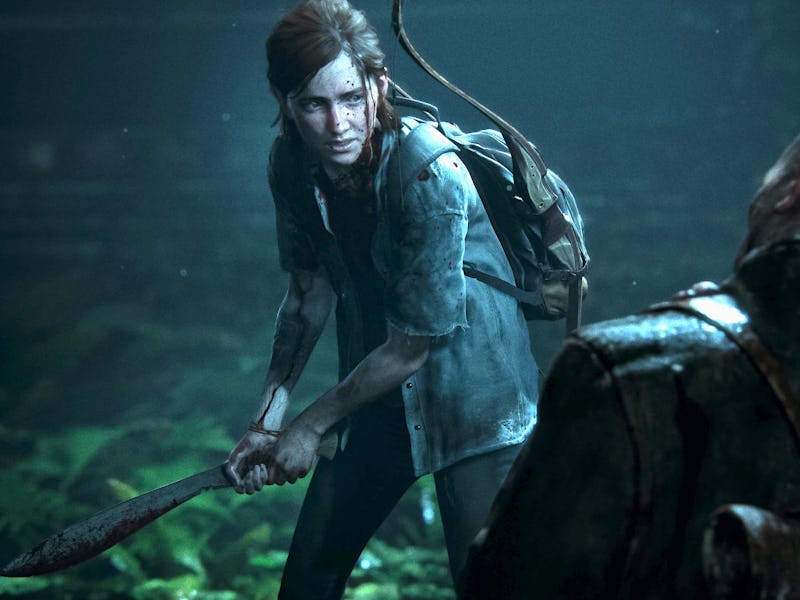Last of Us Part 2 does a Halo 2's plot twist even better
There's a precedent for that shocking moment early on in TLOU 2.

One of the biggest early twists from The Last of Us: Part II compromises the typical hero vs. villain dynamic that's common in most games — and stories in general. In this particular case, it's a gameplay twist that feels almost identical to what happens in Halo 2, but Last of Us 2 developer Naughty Dog uses it to tell an even more impactful story about the blurred lines between good and evil.
Major spoilers for The Last of Us: Part II follow.
When you reach the sixth campaign level of Halo 2, you quickly learn why the alien Elite Thel 'Vadamee featured so prominently in the game's opening cinematic and subsequent cutscenes: We see Covenant forces, including this disgraced Elite who's assumed the religious title of Arbiter, land on a gas mine where they're tasked with assassinating the Heretic leader. The camera zooms in on the Arbiter, who ignites an energy sword, and after a fade through white, we're dumped into his first-person perspective to carry out the mission playing as an alien that the Master Chief would attack on-sight.
The Arbiter and Master Chief in 'Halo 3.'
You control the former villain for this and many other missions in the game, battling Covenant Heretics and other threats throughout Halo 2 and Halo 3, even teaming up directly with the Master Chief to prevent the activation of a Halo ring that would wipe out all sentient life in the galaxy. Halo 2 introduced us to dual-wielding guns and other mechanics that elevated the already impressive first-person shooter experience from the first game, but incorporating the Arbiter into the mix for the story challenges the gamer to see aliens as people with their own culture, motives, and personalities — rather than just targets.
The original Halo: Combat Evolved taught us to worship Master Chief as humanity's greatest hero, but Halo 2 reckons with why the Covenant call him "Demon." From the perspective of their theocratic culture, Master Chief is the bad guy, the unstoppable genocidal maniac who's killed hundreds and thousands of Covenant. And for what? You could argue it's all in self-defense to prevent the annihilation of all humans, but moral relativism might paint John-117 as the villain.
That's not objectively the case, but by forcing gamers to play as the Arbiter, Halo 2 makes us think more critically about this hero-villain dynamic. This twist came as a huge surprise to Halo fans, including myself, when the game was released in 2004, but it proved divisive. If the disparity between critical reviews and audience reviews for The Last of Us: Part 2 is any indication, then that game's use of a similar villainous twist is proving controversial among fans who might be resistant to this kind of ethical challenge.
The Last of Us: Part II forces the player to spend about half their playtime as Abby, the woman who kills Joel — the playable protagonist from the first game — in a brutal early sequence. It's a terrifying act of revenge, and the subsequent time spent as Abby only further makes us acknowledge her own humanity.
Abby is the secondary protagonist in 'The Last of Us Part 2,' but she's also the antagonist.
Most games, particularly shooters, never give us the opportunity to wonder why killing is necessary from a moral standpoint, or to unpack the consequences of a character's violent actions. "The things we shoot at in games aren't really people, but what if they were?" both Halo 2 and The Last of Us Part 2 seem to be asking us. The latter doubles-down on this by naming every enemy, even the dogs, reinforcing this more ethical approach to violence in games.
Is Joel really a hero after the end of the first Last of Us when he kills dozens of Firefly doctors and soldiers who wanted to sacrifice Ellie for the hope of a vaccine? Within the rail-roaded narrative, we're on Joel's side here, but only because those doctors and soldiers were mere targets and not people. Our time spent with Joel and Ellie makes us sympathize with them more, but they're no more or less human than anyone else.
The Last of Us Part II puts us into the shoes of Abby, the daughter of the head doctor Joel murdered in the first game, to help contextualize these moral grey areas. Abby is playable in some early sections leading up to Joel's murder — Joel even saves her life — and then we shift into her perspective for the back-half of the game.
The Fireflies would do anything, even bomb quarantine zones, to destabilize the military occupation of America to restore freedom. They're also willing to sacrifice Ellie to develop the cure. Joel was willing to murder them all just to save Ellie's life, and Abby killing him years later is a direct consequence of that choice. Ellie coming for Abby and her friends is yet another consequence in this cycle of violence. We can hate Abby for what she did to Joel, but from a logical standpoint, we can't blame her unless we blame Joel and Ellie in equal measure. It's a cycle that will only stop when the victims accept rather than retaliate.
Abby's prominent placement as a playable character for half the game means that The Last of Us Part 2 is unlike your typical revenge story. It's one that will keep you thinking even long after the credits roll, and by executing on the same bold storytelling choice that was taken in Halo 2, it moves the conversation forward for how we think about violence in games.
The Last of Us Part II is available now for PS4.